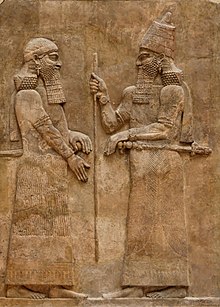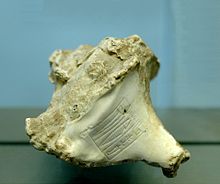پادشاه کائنات
پادشاه کائنات (به سومری: lugal ki-sár-ra [۱] یا lugal kiš-ki , [۲] اکدی: šarru kiššat māti , [۱] šar-kiššati [۱] یا šar kiššatim [۳])، نیز تفسیر شدهاست. به عنوان پادشاه همه چیز، پادشاه تمامیت، پادشاه همه [۲] یا پادشاه جهان، [۴] عنوانی با اعتبار بزرگ بود که مدعی تسلط بر جهان بود که توسط پادشاهان قدرتمند در بینالنهرین باستان استفاده میشد. گاهی این عنوان در سنت یهودی-مسیحی و ابراهیمی به خدا گفته میشود.


ریشهشناسی این عنوان از شهر باستانی سومری کیش (به سومری: kiš, [۵] اکدی: kiššatu [۶]) گرفته شدهاست که معنای اصلی آن پادشاه کیش است. اگرچه معادله šar kiššatim به معنای واقعی کلمه به معنای «شاه کائنات» در دوره اکدی ساخته شد، اما عنوان «پادشاه کیش» قدیمیتر است و از قبل به عنوان شهرت و اعتبار خاصی دیده میشد، زیرا شهر کیش دارای برتری بر تمام شهرهای دیگر میانرودان بود. در افسانه سومری، کیش مکانی بود که پس از طوفان افسانهای، پادشاهی از بهشت به پایین فرود آمد.
اولین فرمانروایی که از عنوان پادشاه جهان استفاده کرد، سارگون بزرگ، پادشاه اکد (حدود ۲۳۳۴–۲۲۸۴ پیش از میلاد) بود و در سلسله امپراتوریهای بعدی که ادعا میکردند تبار نمادین از امپراتوری آکدی سارگون است، استفاده شد. این عنوان آخرین استفاده خود را در زمان سلوکیان مشاهده کرد، آنتیوخوس یکم (۲۸۱–۲۶۱ پیش از میلاد) آخرین فرمانروایی شناخته شدهای بود که از او به عنوان «پادشاه کائنات» یاد میشد.
حداقل در میان فرمانروایان آشور ممکن است که عنوان پادشاه جهان از راههای عادی به ارث نرسیده باشد. از آنجایی که این عنوان برای همه پادشاهان امپراتوری آشوری نو تأیید نشدهاست و برای برخی از آنها تنها چندین سال پس از سلطنت آنها تأیید شدهاست، ممکن است هر پادشاه بهطور جداگانه، احتمالاً از طریق انجام هفت لشکرکشی موفق نظامی، آن را به دست میآورد. عنوان مشابه شاه چهارگوشه جهان (šar kibrāt erbetti) ممکن است مستلزم مبارزات نظامی موفق در هر چهار جهت جغرافیایی باشد. برخی از محققان بر این باورند که القاب پادشاه کائنات و پادشاه چهار گوشه جهان، با معانی تقریباً یکسان، از این جهت متفاوت است که پادشاه کائنات به فرمانروایی بر قلمرو کیهانشناسی اشاره میکند، در حالی که پادشاه چهارگوشه جهان برای تسلط بر زمین به آن اشاره میکند.
منابع
ویرایش- Bevan, Edwyn Robert (1902). "Antiochus III and His Title 'Great-King'". The Journal of Hellenic Studies. 22: 241–244. doi:10.2307/623929. JSTOR 623929. S2CID 163627206.
- Brinkman, J. A. (1968). Political history of Post-Kassite Babylonia (1158-722 b. C.) (A). Gregorian Biblical BookShop.
- Brinkman, J. A. (1990). "Mār-bīti-apla-uṣur". In Ebeling, Erich; Meissner, Bruno; Edzard, Dietz Otto (eds.). Reallexikon Der Assyriologie Und Vorderasiatischen Archãologie: Libanukšbas̆ - Medizin (Vol 7). Walter De Gruyter.
- Crawford, Harriet (2013). The Sumerian World. Routledge. ISBN 978-0-415-56967-5.
- Da Riva, Rocío (2013). The Inscriptions of Nabopolassar, Amel-Marduk and Neriglissar. Walter de Gruyter. ISBN 978-1-61451-587-6.
- Dalley, Stephanie (2013). "Gods from north‐eastern and north‐western Arabia in cuneiform texts from the First Sealand Dynasty, and a cuneiform inscription from Tell en‐Naṣbeh, c.1500 BC". Arabian Archaeology and Epigraphy. 24 (2): 177–185. doi:10.1111/aae.12005.
- Frahm, Eckart (1999). "Reviewed Work: Analysis of Variants in the Assyrian Royal Titulary from the Origins to Tiglath-pileser III by Barbara Cifola". Archiv für Orientforschung. 46/47: 367–373. JSTOR 41668489.
- Frye, Richard Nelson (1983). "The political history of Iran under the Sasanians". The Cambridge History of Iran. 3 (1): 116–180. doi:10.1017/CHOL9780521200929.006. ISBN 978-1-139-05494-2.
- Grayson, A. Kirk (2002) [1996]. Assyrian Rulers of the Early First Millennium BC: II (858–745 BC). Toronto: University of Toronto Press. ISBN 0-8020-0886-0.
- Handy, Lowell K. (1994). Among the host of Heaven: the Syro-Palestinian pantheon as bureaucracy. Eisenbrauns. ISBN 978-0-931464-84-3.
- Hill, Jane A.; Jones, Philip; Morales, Antonio J. (2013). Experiencing Power, Generating Authority: Cosmos, Politics, and the Ideology of Kingship in Ancient Egypt and Mesopotamia. University of Pennsylvania Press. ISBN 978-1-934536-64-3.
- Hoover, Oliver D. (2009). Handbook of Syrian Coins: Royal and Civic Issues, Fourth to First Centuries BC. [The Handbook of Greek Coinage Series, Volume 9]. Classical Numismatic Group. ISBN 978-0-9802387-4-7.
- Johnson, Eric L. (1997). "Christ, the Lord of Psychology". Journal of Psychology and Theology. 25 (1): 11–27. doi:10.1177/009164719702500102. S2CID 170727529.
- Karlsson, Mattias (2013). Early Neo-Assyrian State Ideology Relations of Power in the Inscriptions and Iconography of Ashurnasirpal II (883–859) and Shalmaneser III (858–824). Instutionen för lingvistik och filologi, Uppsala Universitet. ISBN 978-91-506-2363-5.
- Karlsson, Mattias (2016). Relations of Power in Early Neo-Assyrian State Ideology. Walter de Gruyter GmbH & Co KG. ISBN 978-1-61451-968-3.
- Karlsson, Mattias (2017). "Assyrian Royal Titulary in Babylonia". S2CID 6128352.
{{cite journal}}: Cite journal requires|journal=(help) - Kuligowski, Waldemar (2014). "33 meters of sacrum. The analysis of discourses surrounding the statue of Christ the King of the Universe in Świebodzin". Art in Contemporary Cultural Systems. Central and Eastern Europe: 137–148. ISBN 978-83-63795-34-4.
- Kämmerer, Thomas R. (2014). Identities and Societies in the Ancient East-Mediterranean Regions. Ugarit Verlag. ISBN 978-3-86835-062-3.
- Levin, Yigal (2002). "Nimrod the Mighty, King of Kish, King of Sumer and Akkad". Vetus Testamentum. 52 (3): 350–366. doi:10.1163/156853302760197494.
- Liverani, Mario (2013). The Ancient Near East: History, Society and Economy. Routledge. ISBN 978-0-415-67906-0.
- Luckenbill, Daniel David (1925). "The First Inscription of Shalmaneser V". The American Journal of Semitic Languages and Literatures. 41 (3): 162–164. doi:10.1086/370064. S2CID 170658223.
- Luckenbill, Daniel David (1927). Ancient Records of Assyria and Babylonia Volume 2: Historical Records of Assyria From Sargon to the End. University of Chicago Press.
- McIntosh, Jane R. (2017). Mesopotamia and the Rise of Civilization: History, Documents, and Key Questions. ABC-CLIO. ISBN 978-1-4408-3546-9.
- Miller, James Maxwell (1986). A History of Ancient Israel and Judah. Westminster John Knox Press. ISBN 978-0-664-22358-8.
- Maeda, Tohru (1981). ""King of Kish" in Pre-Sargonic Sumer". Orient. 17: 1–17. doi:10.5356/orient1960.17.1.
- Mondzain, Marie-José; Franses, Rico (2013). "Iconic Space and the Rule of Lands". Hypatia. 15 (4): 58–76. JSTOR 3810674.
- Peat, Jerome (1989). "Cyrus "King of Lands," Cambyses "King of Babylon": The Disputed Co-Regency". Journal of Cuneiform Studies. 41 (2): 199–216. doi:10.2307/1359915. JSTOR 1359915. S2CID 163504463.
- Pongratz-Leisten, Beate (2015). Religion and Ideology in Assyria. Walter de Gruyter GmbH & Co KG. ISBN 978-1-61451-482-4.
- Roaf, Michael; Zgoll, Annette (2001). "Assyrian Astroglyphs: Lord Aberdeen's Black Stone and the Prisms of Esarhaddon". Zeitschrift für Assyriologie und Vorderasiatische Archäologie. 91 (2): 264–295. doi:10.1515/zava.2001.91.2.264. S2CID 161673588.
- Ristvet, Lauren (2015). Ritual, Performance, and Politics in the Ancient Near East. Cambridge University Press. ISBN 978-1-107-06521-5.
- Rollinger, Robert (2017). "Dadusa's stela and the vexed question of identifying the main actors on the relief". Iraq. 79: 203–212. doi:10.1017/irq.2017.6. S2CID 165075295.
- Steinkeller, Piotr (2013). "An archaic "prisoner plaque" from kiš". Revue d'assyriologie et d'archéologie orientale. 107: 131–157. doi:10.3917/assy.107.0131.
- Stevens, Kahtryn (2014). "The Antiochus Cylinder, Babylonian Scholarship and Seleucid Imperial Ideology" (PDF). The Journal of Hellenic Studies. 134: 66–88. doi:10.1017/S0075426914000068. JSTOR 43286072.
- Van De Mieroop, Marc (2005). Cuneiform Texts and the Writing of History. Routledge. ISBN 978-0-415-19533-1.
- Yamada, Shigeo (2014). "Inscriptions of Tiglath-pileser III: Chronographic-Literary Styles and the King's Portrait". Orient. 49: 31–50. doi:10.5356/orient.49.31.
- Zimansky, Paul E. (1985). "Ecology and Empire: The Structure of the Urartian State". Studies in Ancient Oriental Civilization (SAOC). 41: 295–310.